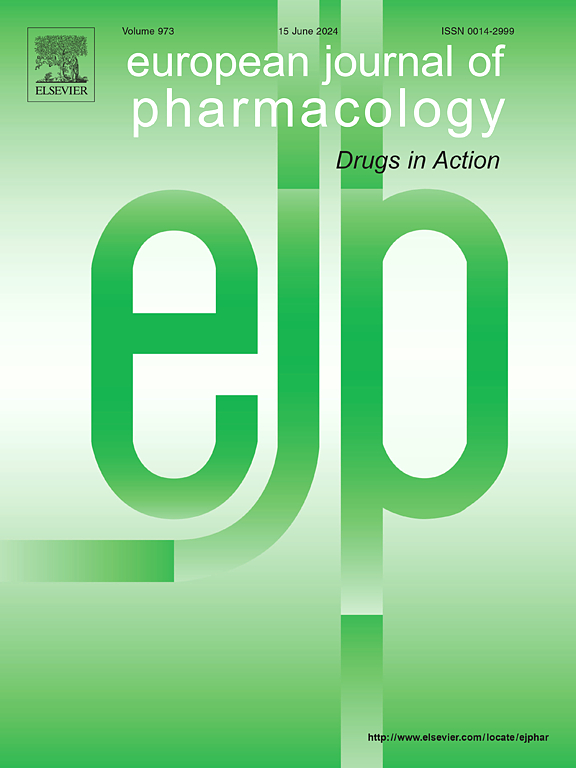Synergistic effects of BET inhibitors and ferroptosis inducers via targeted inhibition of the BRD4/c-Myc/NRF2 pathway in AML
IF 4.2
3区 医学
Q1 PHARMACOLOGY & PHARMACY
引用次数: 0
Abstract
In acute myeloid leukemia (AML), high expression of BRD4 is associated with poor prognosis. BET inhibitors that mainly inhibit BRD4 can induce AML cell death, but some AML cells are insensitive to BET inhibitors. We found that BET inhibitors could promote the up-regulation of the ferroptosis signaling pathway in AML. In this study, we intend to investigate the synergistic effects of BET inhibitors with ferroptosis inducers in AML cells. The combination of BET inhibitors with ferroptosis inducers (RSL3, FIN56, and Erastin) markedly reduced AML cell viability and increased cell death, as demonstrated by CCK-8 assays and flow cytometry analysis across multiple AML cell lines and primary AML patient samples. Moreover, BET inhibitors combined with ferroptosis inducers elevated the lipid reactive oxygen species (ROS) levels, indicating heightened lipid peroxidation, a hallmark of ferroptosis. Mechanistically, BET inhibitor and ferroptosis inducer co-targeted the BRD4/c-Myc/NRF2 axis, leading to downregulation of NRF2, key regulators of AML cell survival and oxidative stress resistance. NRF2 knockdown amplified the anti-AML effect of this combined treatment, whereas NRF2 overexpression negated this synergy, highlighting its critical role in mediating ferroptosis resistance. Finally, survival analyses of AML patients from the TCGA and GSE71014 datasets revealed that elevated expression of BRD4, NRF2, and its downstream target GPX4, an essential ferroptosis regulator, correlated with poor overall survival, highlighting the clinical relevance of our findings. In all, combining BET inhibition with ferroptosis induction could enhance anti-leukemia effect and represent a novel therapeutic strategy for targeting AML cells.

BET抑制剂和铁凋亡诱导剂通过靶向抑制BRD4/c-Myc/NRF2通路在AML中的协同作用
在急性髓性白血病(AML)中,BRD4的高表达与不良预后相关。主要抑制BRD4的BET抑制剂可诱导AML细胞死亡,但部分AML细胞对BET抑制剂不敏感。我们发现BET抑制剂可以促进AML中铁下垂信号通路的上调。在这项研究中,我们打算研究BET抑制剂与铁下垂诱导剂在AML细胞中的协同作用。CCK-8检测和流式细胞术分析显示,BET抑制剂与铁凋亡诱导剂(RSL3、FIN56和Erastin)联合使用可显著降低AML细胞活力,增加细胞死亡。此外,BET抑制剂联合铁下垂诱导剂提高了脂质活性氧(ROS)水平,表明脂质过氧化水平升高,这是铁下垂的一个标志。在机制上,BET抑制剂和铁凋亡诱导剂共同靶向BRD4/c-Myc/NRF2轴,导致NRF2下调,NRF2是AML细胞存活和氧化应激抵抗的关键调节因子。NRF2敲低增强了这种联合治疗的抗aml作用,而NRF2过表达则否定了这种协同作用,突出了其在介导铁下垂抵抗中的关键作用。最后,来自TCGA和GSE71014数据集的AML患者的生存分析显示,BRD4、NRF2及其下游靶点GPX4(一种必需的铁下沉调节因子)的表达升高与较差的总生存率相关,突出了我们研究结果的临床相关性。综上所述,将BET抑制与诱导铁下垂相结合可以增强抗白血病的效果,代表了一种针对AML细胞的新的治疗策略。
本文章由计算机程序翻译,如有差异,请以英文原文为准。
求助全文
约1分钟内获得全文
求助全文
来源期刊
CiteScore
9.00
自引率
0.00%
发文量
572
审稿时长
34 days
期刊介绍:
The European Journal of Pharmacology publishes research papers covering all aspects of experimental pharmacology with focus on the mechanism of action of structurally identified compounds affecting biological systems.
The scope includes:
Behavioural pharmacology
Neuropharmacology and analgesia
Cardiovascular pharmacology
Pulmonary, gastrointestinal and urogenital pharmacology
Endocrine pharmacology
Immunopharmacology and inflammation
Molecular and cellular pharmacology
Regenerative pharmacology
Biologicals and biotherapeutics
Translational pharmacology
Nutriceutical pharmacology.

 求助内容:
求助内容: 应助结果提醒方式:
应助结果提醒方式:


